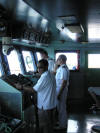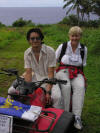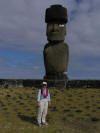|
Tahiti to Easter Island
October 2003
 OK,
right off the bat we confess: this wasn't a cruise aboard Raven. But it
was a cruise, albeit aboard a small, expedition-type cruise ship called
Clipper Odyssey, and we did go to some pretty exotic places and had a great
time. We hope this report will bring a little warmth to these dark winter
days. OK,
right off the bat we confess: this wasn't a cruise aboard Raven. But it
was a cruise, albeit aboard a small, expedition-type cruise ship called
Clipper Odyssey, and we did go to some pretty exotic places and had a great
time. We hope this report will bring a little warmth to these dark winter
days.
 We had never taken an organized trip before,
much less on a cruise ship, perish the thought. But this cruise, titled
a little pretentiously "Beyond Rapa Nui II" and organized by a Seattle
company named Zegrahm (click for their
website),
seemed like the place and time to give it a shot. Besides, it would take us
to some South Pacific islands that are tough to reach in a sailboat,
including Easter and Pitcairn. We had never taken an organized trip before,
much less on a cruise ship, perish the thought. But this cruise, titled
a little pretentiously "Beyond Rapa Nui II" and organized by a Seattle
company named Zegrahm (click for their
website),
seemed like the place and time to give it a shot. Besides, it would take us
to some South Pacific islands that are tough to reach in a sailboat,
including Easter and Pitcairn.
This log update is going to be mostly a photo
gallery, as the Zegrahm website has an excellent log (click
here) of the full cruise. We'll just add a little of our own
perspective.
Don't forget: Click on any photo to see it
full size.
Clipper Odyssey and Zegrahm
 After flying to Tahiti, we
boarded the ship at the commercial dock in Papeete, to the music of a
Tahitian dance troupe. This was a bit of warm
nostalgia for us, since we spent a month there last year during Heiva (see
the Tahiti and Moorea log). We
rode on le truck, changed some money, and visited the wonderful
market for a flower crown and a pareo for Signe. We felt like old hands when the
tour took us on a round-the-island trip to familiar places. After flying to Tahiti, we
boarded the ship at the commercial dock in Papeete, to the music of a
Tahitian dance troupe. This was a bit of warm
nostalgia for us, since we spent a month there last year during Heiva (see
the Tahiti and Moorea log). We
rode on le truck, changed some money, and visited the wonderful
market for a flower crown and a pareo for Signe. We felt like old hands when the
tour took us on a round-the-island trip to familiar places.
  Clipper
Odyssey seemed huge compared to Raven, but next to the real cruise ship
across the dock, it looked like a dinghy. Our cabin was on the top deck -- a
disadvantage because of the extra motion at sea, it turned out later -- and
had a tiny little terrace with just enough room for a couple of chairs.
There were only 80 of us passengers and a crew of cheery and competent
Filipinos who outnumbered us. Clipper
Odyssey seemed huge compared to Raven, but next to the real cruise ship
across the dock, it looked like a dinghy. Our cabin was on the top deck -- a
disadvantage because of the extra motion at sea, it turned out later -- and
had a tiny little terrace with just enough room for a couple of chairs.
There were only 80 of us passengers and a crew of cheery and competent
Filipinos who outnumbered us.
 In addition, the ship carried
several Zegrahm's organizers, leaders, and lecturers. We had a fish guy
(easier to say than ichthyologist), a bird guy (there were some varsity
birders, all sporting their "life lists" among the passengers), an oceans
and reefs guy, an archeologist, and a literature guy who told tales and
recited poems about the storied South Pacific. All the days were
action-packed and, if there was a free hour, we would have a lecture on some
pertinent subject. In addition, the ship carried
several Zegrahm's organizers, leaders, and lecturers. We had a fish guy
(easier to say than ichthyologist), a bird guy (there were some varsity
birders, all sporting their "life lists" among the passengers), an oceans
and reefs guy, an archeologist, and a literature guy who told tales and
recited poems about the storied South Pacific. All the days were
action-packed and, if there was a free hour, we would have a lecture on some
pertinent subject.
Following is a very short
version of a cruise that we thoroughly enjoyed.
Tahiti
and Moorea
 Even though this was a revisit
for us, there's no getting around the beauty of the bays of Moorea. This is
when Jan figured out how to shoot panoramic shots with our new digital
camera, so brace yourself for a panoramic overload! Even though this was a revisit
for us, there's no getting around the beauty of the bays of Moorea. This is
when Jan figured out how to shoot panoramic shots with our new digital
camera, so brace yourself for a panoramic overload!
Austral Islands
  We
visited Tubuai, Raivavae, and Rapa in this group of islands, part of France
Polynesia. They're several hundred miles south of Tahiti, more subtropical
in climate, and far less used to tourists. They get a few yachts every year
but never any cruise ships, so our arrival was We
visited Tubuai, Raivavae, and Rapa in this group of islands, part of France
Polynesia. They're several hundred miles south of Tahiti, more subtropical
in climate, and far less used to tourists. They get a few yachts every year
but never any cruise ships, so our arrival was
 the
event of the year on the
event of the year on
 each
island. We received big receptions everywhere, with music, dancers, buffets
of native delicacies, and flowered crowns or leis. each
island. We received big receptions everywhere, with music, dancers, buffets
of native delicacies, and flowered crowns or leis.
  Rapa
was the most rugged and remote island, and the whole island turned out to
greet and entertain us. School was canceled for the day and locals and
guests enjoyed a performance by the local dancers with the school teacher as
an emcee. His only English was a loud, "Clap now!" Rapa
was the most rugged and remote island, and the whole island turned out to
greet and entertain us. School was canceled for the day and locals and
guests enjoyed a performance by the local dancers with the school teacher as
an emcee. His only English was a loud, "Clap now!"
 Rapa
was the site of our most spectacular hike, up to one of the hilltop forts
that date from the prehistoric wars on the island. Rapa
was the site of our most spectacular hike, up to one of the hilltop forts
that date from the prehistoric wars on the island.
Mangareva
  Mangareva
is at the extreme southeast end of the Tuamotu chain -- you remember we
visited Makemo and Fakarava in the Tuamotus last year -- but still Mangareva
is at the extreme southeast end of the Tuamotu chain -- you remember we
visited Makemo and Fakarava in the Tuamotus last year -- but still
 has
those wonderful pearl farms. Signe spread the word and everyone indulged a
little. We even discovered a Catholic-run school t has
those wonderful pearl farms. Signe spread the word and everyone indulged a
little. We even discovered a Catholic-run school t hat
teaches teenagers from all over Polynesia to carve beautiful mother-of-pearl
necklaces, bracelets, etc. hat
teaches teenagers from all over Polynesia to carve beautiful mother-of-pearl
necklaces, bracelets, etc.
 The
island also had an immense cathedral, far beyond the needs of the island,
built in the 19th century on the orders of a megalomaniac priest from
France. The
island also had an immense cathedral, far beyond the needs of the island,
built in the 19th century on the orders of a megalomaniac priest from
France.
Pitcairn
  This
is the remote island where the Bounty mutineers hid from the British Navy
for thirty years, and where 41 of their descendents still live. It seems
that half the population is named "Christian" and claims Fletcher Christian
as an ancestor. This
is the remote island where the Bounty mutineers hid from the British Navy
for thirty years, and where 41 of their descendents still live. It seems
that half the population is named "Christian" and claims Fletcher Christian
as an ancestor.
  We
were lucky enough to be taken ashore in the islanders' longboats on two
successive days. The sea was rough, so boarding the longboats was no picnic,
but the crew handled it with no mishaps. Pitcairn sees a dozen cruise ships
a year, but the passengers never get to land, both because We
were lucky enough to be taken ashore in the islanders' longboats on two
successive days. The sea was rough, so boarding the longboats was no picnic,
but the crew handled it with no mishaps. Pitcairn sees a dozen cruise ships
a year, but the passengers never get to land, both because
 of
the rough seas, and the number of people on those big ships would overwhelm
the island. The entire population also came out to the ship for dinner and
lunch. Tom Christian, the island patriarch, and his wife sat with us for
dinner and a lesson in living on a totally isolated island. of
the rough seas, and the number of people on those big ships would overwhelm
the island. The entire population also came out to the ship for dinner and
lunch. Tom Christian, the island patriarch, and his wife sat with us for
dinner and a lesson in living on a totally isolated island.
Henderson and Ducie
  These
are two uninhabited islands, part of the Pitcairn group, that are well known
to biologists for their unique bird life. Most birders would kill to visit
these islands and put the Henderson island crake or reed warbler on their
life lists. Landing in the Zodiacs over the reef and onto the beaches was no
mean These
are two uninhabited islands, part of the Pitcairn group, that are well known
to biologists for their unique bird life. Most birders would kill to visit
these islands and put the Henderson island crake or reed warbler on their
life lists. Landing in the Zodiacs over the reef and onto the beaches was no
mean
 feat,
but again our crew was magnificent in safely landing all 80 of us to explore
ashore. feat,
but again our crew was magnificent in safely landing all 80 of us to explore
ashore.
Easter Island
  Yes,
Easter was the highlight of our cruise and we even stayed an extra four days
for an intensive tour. We are always most interested in the people of the
islands, so the history and archeology of Easter we top on our list. The
guide Zegrahm provided was Claudio Cristino, the Chilean archeologist who
has spent 27 years excavating on Easter (it's a province of Chile). By the
way, the Polynesian name for Easter is Rapa Nui. Yes,
Easter was the highlight of our cruise and we even stayed an extra four days
for an intensive tour. We are always most interested in the people of the
islands, so the history and archeology of Easter we top on our list. The
guide Zegrahm provided was Claudio Cristino, the Chilean archeologist who
has spent 27 years excavating on Easter (it's a province of Chile). By the
way, the Polynesian name for Easter is Rapa Nui.
  It's
not until you reach the volcano/quarry where the moai statues were
carved that you realize there are hundreds and hundreds of these immense
carvings, most never having reached their intended altars. There are quite a
few half-finished figures still attached to the living rock. It's
not until you reach the volcano/quarry where the moai statues were
carved that you realize there are hundreds and hundreds of these immense
carvings, most never having reached their intended altars. There are quite a
few half-finished figures still attached to the living rock.
  One
of the photos shows Claudio Cristino in front of his magnum opus, the
restoration of the immense altar and statue at Tongariki. It's hard One
of the photos shows Claudio Cristino in front of his magnum opus, the
restoration of the immense altar and statue at Tongariki. It's hard
 to
convey with a photo the overwhelming impression this site makes on you. We
marveled at the skill of Polynesians, first in navigating to this remote
island, then in building the statues. Many of the altars still contain human
bones, as Claudio shows in the photo. to
convey with a photo the overwhelming impression this site makes on you. We
marveled at the skill of Polynesians, first in navigating to this remote
island, then in building the statues. Many of the altars still contain human
bones, as Claudio shows in the photo.
All in all, a tremendously successful trip. We
hope to do a few more of these Zegrahm voyages to exotic destinations.
Love . . .
Signe & Jan
Previous log
Next log
This page was last
updated on
04/13/04. |